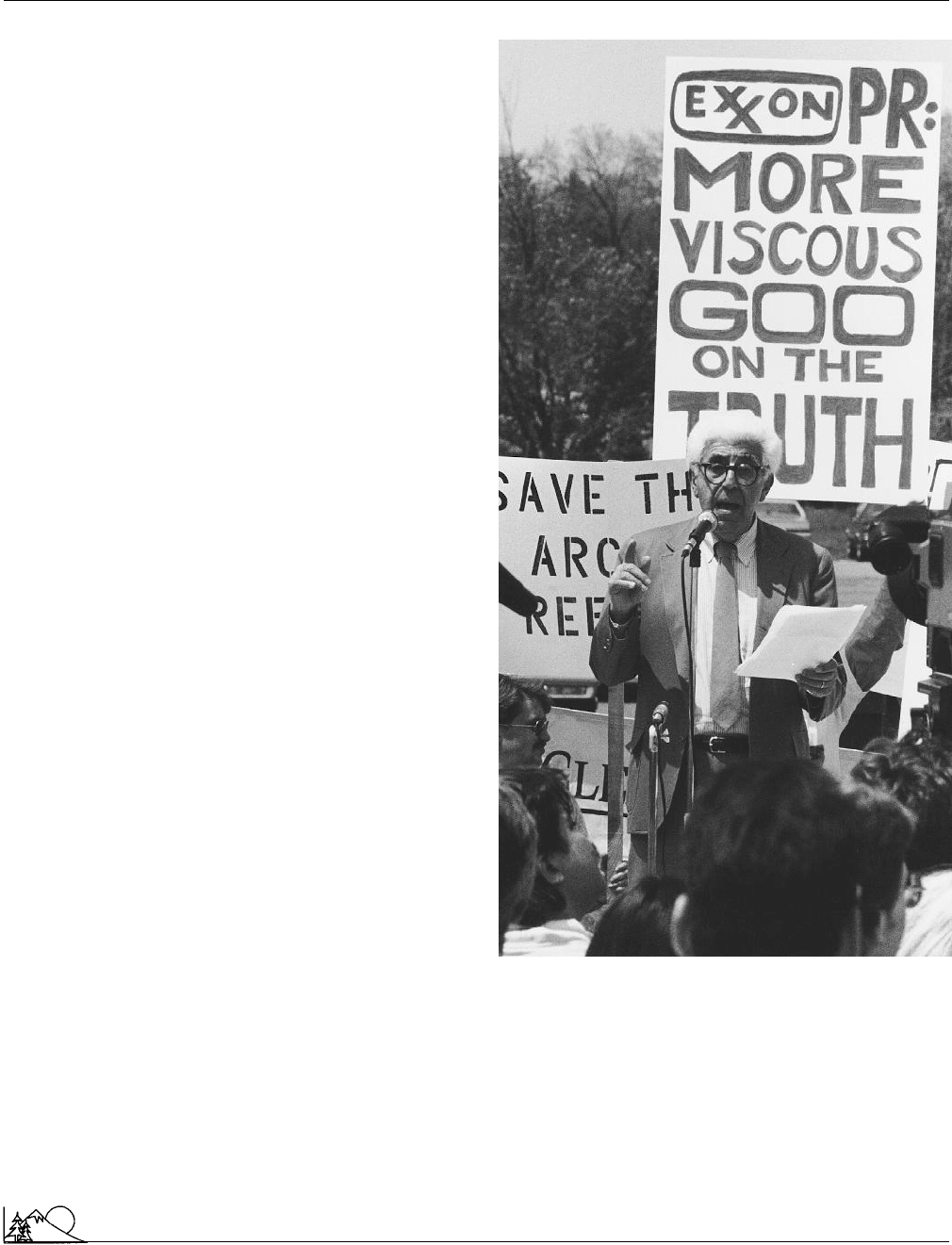Environmental Encyclopedia
Подождите немного. Документ загружается.


Environmental Encyclopedia 3
Commercial fishing
comparable to that of humans and adults typically grow to
500 lb (227 kg). The success of a 1982 ban on fishing the
black sea bass off the coast of California became evident
early this century when significant numbers of these young
fish, already weighing as much as 200 lb (91 kg), appeared
off the shores of Santa Barbara. Yet, full replenishment of
the population remains years away.
Environmental problems also
plague
commercial
fishing. Near-shore
pollution
has altered ecosystems, taking
a heavy toll on all populations of fish and shellfish, not
only those valued commercially. The collective actions of
commercial fishermen also create some major environmental
problems. The world’s commercial fishermen annually catch
and then discard about 20 billion lb (9 billion kg) of non-
target species of sea life. In addition to fish and shellfish,
each year about one million seabirds are caught and killed
in fishermen’s nets. On average more than 6,000
seals and
sea lions
, about 20,000
dolphins
and other aquatic mam-
mals, and thousands of
sea turtles
meet the same fate. It
is estimated that the amount of fish discarded annually is
about 25% of the reported catch, or about 20 million metric
tons per year. Ecologically, two major problems arise from
this massive disposal of organisms. One is the disruption
of predator-prey ratios, and the other is the addition of a
tremendous overload of
organic waste
to be dealt with in
this
ecosystem
.
In 2001, a $1.6 billion gas pipeline that was proposed
to be routed through neighboring waters from Nova Scotia
to New Jersey, to be implemented as early as 2005, posed
a new environmental threat to the Georges Bank area. Envi-
ronmentalists, meanwhile, have lobbied the United States
government to establish a marine
habitat
protection desig-
nation similar to
wilderness
areas and natural parks on
land, to provide for the preservation of reefs, marine life,
and underwater vegetation. In 2001, less than 1% of
water
resources
worldwide had the protection of formal legisla-
tion to prevent exploitation.
Habitat destruction is serious environmental concern.
Fish and other aquatic
wildlife
rely on the existence of high
quality habitat for their survival, and loss of habitat is one
of the most pressing environmental threats to shorelines,
wetlands
, and other aquatic habitats. Approaches to the
protection of
essential fish habitat
include efforts to
strengthen and vigorously enforce the
Clean Water Act
and
other protective legislation for aquatic habitats, to develop
and implement restoration plans for target regions, to make
improved policy decisions based on technical knowledge
about shoreline habitats, and to better educate the public
on the importance of protecting and restoring habitat. A
relatively new approach to habitat recovery is the habitat
conservation
plan (HCP), in which a multi-species ecosys-
tem approach to habitat management is preferred over a
287
reactive species-by-species plan. Strategies for fish recovery
are complex, and, instead of numbers of fish of a given
species, the HCP uses quality of habitat to measure the
success of restoration and conservation efforts. Long-term
situations such as the restoration of black sea bass serve to
re-emphasize the importance of resisting the temptation to
manage overfishing of single species while failing to address
the survival of the ecosystem as a whole.
The Magnuson-Stevens Fishery Conservation and
Management Act was passed in 1976 to regulate fisheries
resources and fishing activities in Federal waters, those wa-
ters extending to the 200-mi (322-km) limit. The act recog-
nizes that commercial fishing contributes to the food supply
and is a major source of employment, contributing signifi-
cantly to the economy of the Nation. However, it also recog-
nizes that overfishing and habitat loss has led to the decline
of certain species of fish to the point where their survival is
threatened, resulting in a diminished capacity to support
existing fishing levels. Further, international fishery
agreements have not been effective in ending or preventing
overfishing. Fishery resources are limited but renewable and
can be conserved and maintained to continue to provide good
yields. Also, the act supports the development of underused
fisheries, such as bottom-dwelling fish near Alaska.
Another resource to sustain increases in seafood con-
sumption is
aquaculture
, where commercial food-fish spe-
cies are grown on fish farms. It is estimated that the amount
of farm-raised fish has doubled in the past decade and that
about 20% of the fish consumed worldwide is raised in
captivity.
In the United States, as well as other nations, the
commercial fisheries industry faces potential collapse. Severe
restrictions and tight controls imposed by the international
community may be the only means of salvaging even a por-
tion of this valuable industry. It will be necessary for partner-
ships to be forged between scientists, fisherman, and the
regulatory community to develop and implement measures
toward maintaining a sustainable fishery.
[Eugene C Beckham]
R
ESOURCES
B
OOKS
Bricklemyer, E., S. Iudicello, and H. Hartmann. “Discarded Catch in U.S.
Commercial Marine Fisheries.” In Audubon Wildlife Report 1990-1991. San
Diego: Academic Press, 1990.
Weber, M. “Federal Marine Fisheries Management.” In Audubon Wildlife
Report 1986. San Diego: Academic Press, 1986.
P
ERIODICALS
Lawren, B. “Net Loss.” National Wildlife 30 (1992): 46-53.
Associated Press, February 19, 2001.

Environmental Encyclopedia 3
Commission for Environmental Cooperation
O
THER
Dudley-Cash, William A. “ Aquaculture has been the world’s fastest grow-
ing food production system.” Factoryfarming.com: Factory Seafood Production
June 29, 1998 [cited July 9, 2002] < http://www.factoryfarming.com/
fish.html>.
Guinan, John A. and Ralph E. Curtis “A Century Of Conservation.”
NMFS National Marine Fisheries Service, April 1971 [cited July 9, 2002]
<http://www.nefsc.nmfs.gov/library/history/century.html>.
Loftas, Tony “Not enough fish in the sea.” Our Planet 7.6 April 1996
[cited July 9, 2002] <http://www.ourplanet.com/imgversn/76/loftas.html>.
Magnuson-Stevens Fishery Conservation and Management Act, Public Law
94-265 (as amended through October 11, 1996). [cited July 9, 2002] <http://
www.nmfs.noaa.gov/sfa/magact/>.
Vogel, William and Lorin Hicks “Multi-species HCPs:Experiments with
the Ecosystem Approach.” Endangered Species Bulletin July/August 2000,
Vol. 25, No. 4, pp. 20-22 [cited July 9, 2002] <http://endangered.fws.gov/
esb/2000/07-08/20-22.pdf>.
Commingled recyclables
see
Recycling
Commission for Environmental
Cooperation
The Commission for Environmental Cooperation (CEC) is
a trilateral international commission established by Canada,
Mexico, and the United States in 1994 to address trans-
boundary environmental concerns in North America. The
original impetus behind the CEC was the perception of
inadequacies in the environmental provisions of the
North
American Free Trade Agreement
(NAFTA). A supple-
mentary treaty, the North American Agreement for Envi-
ronmental Cooperation (NAAEC) was negotiated to rem-
edy these inadequacies, and it is from the NAAEC that the
CEC derives its formal mandate.
The general goals set forth by the NAAEC are to
protect, conserve, and improve the
environment
for the
benefit of present and
future generations
. More specifi-
cally, the three NAFTA signatories agreed to a core set of
actions and principles with regard to environmental concerns
related to trade policy. These actions and principles include
regular reporting on the state of the environment, effective
and consistent enforcement of
environmental law
, facilita-
tion of access to environmental information, the ongoing
improvement of environmental laws and regulations, and
promotion of the use of tax incentives and various other
economic instruments to achieve environmental goals.
The CEC is to function as a forum for the NAFTA
partners to identify and articulate mutual interests and priori-
ties, and to develop strategies for the pursuit or implementa-
tion of these interests and priorities. The NAAEC further
specifies the following priorities: identification of appro-
priate limits for specific pollutants; the protection of endan-
288
gered and threatened
species
; the protection and
conserva-
tion
of wild
flora
and
fauna
and their
habitat
; the
development of new approaches to environmental compli-
ance and enforcement; strategies for addressing environmen-
tal issues that have impacts across international borders; the
support of training and education in the environmental field;
and promotion of greater public awareness of North Ameri-
can environmental issues. Central to the CEC’s mission is
the facilitation of dialogue among the NAFTA partners in
order to prevent and solve trade and environmental disputes.
The governing body of the CEC is a Council of Minis-
ters consisting of the environment ministers (or equivalent)
from each country. The executive arm of the Commission
is a Secretariat located in Montreal, consisting of a staff of
about 30 members and headed by an Executive Director.
The staff is drawn from all three countries and provides
technical and administrative support to the Council of Min-
isters and to committees and groups established by the
Council.
Technical and scientific advice is also provided to the
Council of Ministers by a Joint Public Advisory Committee
consisting of five members from each country appointed by
the respective governments. This Committee may, on its
own initiative, advise the Council on any matter within the
scope of the NAAEC, including the annual program and
budget. As a reflection of the CEC’s professed commitment
to participation by citizens throughout North America, the
Committee is intended to represent a wide cross-section of
knowledgeable citizens committed to environmental con-
cerns who are willing to volunteer their time in the public
interest. The CEC also accepts direct input from any citizen
or non-governmental organization who believes that a
NAFTA partner is failing to enforce effectively an existing
environmental law.
The NAAEC also contains provisions for dispute res-
olution in cases in which a NAFTA signatory alleges that
another NAFTA partner has persistently failed to enforce an
existing environmental law, causing specific environmental
damage or trade disadvantages to the claimant. These provi-
sions may be invoked when a lack of effective enforcement
materially affects goods or services being traded between the
NAFTA countries. If the dispute is not resolved through
bilateral consultation, the complaining party may then re-
quest a special session of the CEC’s Council of Ministers.
If the Council is likewise unable to resolve the dispute,
provisions exist for choosing an Arbitral Panel. Failure to
implement the recommendations of the Arbitral Panel sub-
jects the offending party to a monetary enforcement assess-
ment. Failure to pay this assessment may lead to suspension
of free trade benefits.
The Council is also instructed to develop recommen-
dations on access to courts (and rights and remedies before

Environmental Encyclopedia 3
Barry Commoner
courts and administrative agencies) for persons in one coun-
try’s territory who have suffered or are likely to suffer damage
or injury caused by
pollution
originating in the territory of
one of the other countries. In 2002, the Council published
a five year study which stated that 3.4 million tonnes of
toxins
were produced in North America.
The CEC has been subject to some of the same criti-
cisms leveled at the environmental provisions of NAFTA,
particularly that it serves as a kind of environmental window-
dressing for a trade agreement that is generally harmful to
the environment. The CEC’s mandate for conflict resolution
is primarily oriented towards consistent enforcement of ex-
isting environmental law in the three countries. This law is
by no means uniform. By upholding the principles of free
trade, and providing penalties for infringements of free trade,
NAFTA establishes an environment in which private com-
panies have an economic incentive, other considerations be-
ing equal, to locate production where environmental laws
are weakest and the costs of compliance are therefore lowest.
Countries with stricter environmental regulations face penal-
ties for attempting to protect domestic industries from such
comparative disadvantages.
[Lawrence J. Biskowski]
R
ESOURCES
O
THER
Kass, S. L. “First Cases Before New NAFTA Forum Suggest Its Power
Will Increase.” National Law Journal 18/41 (10 June 1996): C5, C7.
O
RGANIZATIONS
Commission for Environmental Cooperation, 393, rue St-Jacques Ouest,
Bureau 200, Montre
´
al, Que
´
becCanada H2Y 1N9 (514) 350-4300, Fax:
(514) 350-4314, Email: info@ccemtl.org, <http://www.cec.org>
Barry Commoner (1917 – )
American biologist, environmental scientist, author, and
social activist
Born to Russian immigrant parents, Commoner earned a
doctorate in biology from Harvard in 1941. As a biologist,
he is known for his work with free radicals—chemicals like
chlorofluorocarbons
, which are suspected culprits in
ozone layer depletion
. Commoner led a fairly academic
life at first, with research posts at various universities, but
rose to some prominence in the late 1950s, when he and
others protested atmospheric testing of
nuclear weapons
.
He earned a national reputation in the 1960s with books,
articles, and speeches on a wide range of environmental
concerns, including
pollution
,
alternative energy sources
,
and population. His latest book, Making Peace with the
Planet, was published in 1990. Commoner’s other works
include Science and Survival (1967), The Closing Circle
289
Barry Commoner speakingto a group of pro-
testers gathered outside a New Jersey hotel
where Exxon stockholders met in 1989. (Corbis-
Bettmann. Reproduced by permission.)
(1971), Energy and Human Welfare (1975), The Poverty of
Power (1976), and The Politics of Energy (1979).
Commoner believes that post-World War II industrial
methods, with their reliance on nonrenewable
fossil fuels

Environmental Encyclopedia 3
Communicable diseases
are the root cause of modern environmental pollution. When
combined with a myopic view of the bottom line, he states,
the devastation is complete: “At present, economic consider-
ations—in particular, the private desire for maximizing
short-term profits—govern the choice of productive technol-
ogy, which in turn determines its environmental impact,
generally for the worse.” The petrochemicals industry re-
ceives the largest share of Commoner’s criticism. He refers
to “the
petrochemical
industry’s toxic invasion of the bio-
sphere” and states flatly that “the petrochemical industry is
inherently inimical to environmental quality.”
Almost as distressing as environmental pollution is
our inability to clean it up. Commoner rejects attempts at
environmental regulation as pointless. Far better, he says,
to not produce the toxin in the first place. “When a pollutant
is attacked at the point of origin—in the production process
that generates it—the pollutant can be eliminated; once it
is produced, it is too late. This is the simple but powerful
lesson of the two decades of intense but largely futile effort
to improve the quality of the environment.”
Commoner offers radical, sweeping solutions for social
and ecological ills. The most urgent of these is a
renewable
energy
source, primarily photovoltaic cells powered by
so-
lar energy
. These would not only decentralize
electric utili-
ties
(another target of Commoner’s), but would use sunlight
to fuel almost any energy need, including smaller, lighter,
battery-powered cars. To ease the transition from fossil fuels
to solar power, he proposes
methane
,
cogeneration
(which
produces electricity from waste heat), and an organic agricul-
ture system that would “produce enough
ethanol
to replace
about 20 percent of the national demand for
gasoline
with-
out reducing the overall supply of food or significantly affect-
ing its price.”
Commoner makes few compromises, and his environ-
mental zeal has made him a crusader for social causes as
well. Eliminating
Third World
debt, he argues, would
improve life in impoverished countries and end the spiral
of economic desperation that drives countries to overpopu-
lation. “This [debt forgiveness] should be regarded not as
a magnanimous gesture but as partial reparations for the
damage inflicted...by the former colonial empires...[T]he
cause of poverty is the grossly unequal distribution of the
world’s wealth...we must redistribute that wealth, among
nations and within them.”
In 1980, Commoner made a bid for the presidency
on the Citizen’s Party ticket, a short-lived political attempt
to combine environmental and Socialist agendas. Since 1981
he has been the director of the Center for the Biology of
Natural Systems at Queens College in New York City.
[Muthena Naseri and Amy Strumolo]
290
R
ESOURCES
B
OOKS
Commoner, B. The Closing Circle. New York: Knopf, 1971.
———. Making Peace With the Planet. New York: New Press, 1992.
P
ERIODICALS
Commoner, B. “Ending the War Against Earth.” The Nation 250 (30 April
1990): 589–90.
———. “The Failure of the Environmental Effort.” Current History 91
(April 1992): 176–81.
Stone, P. “The Ploughboy Interview.” Mother Earth News (March–April
1990): 116–26.
Communicable diseases
A communicable disease is any disease that can be transmit-
ted from one organism to another. Agents that cause com-
municable diseases, called pathogens, are easily spread by
direct or indirect contact. These pathogens include viruses,
bacteria,
fungi
, and
parasites
. Some pathogens make
tox-
ins
that harm the body’s organs. Others actually destroy
cells. Some can impair the body’s natural immune system,
and opportunistic organisms set up secondary infections that
cause serious illness or death. Once the pathogens have
multiplied inside the body, signs of illness may or may not
appear. The human body is adept at destroying most patho-
gens, but the pathogens may still multiply and spread.
The pathogens responsible for some communicable
diseases have been known since the mid-1800s, although
they have existed for a much longer period of time. European
explorers brought highly contagious diseases such as small-
pox, measles, typhus and scarlet fever to the New World,
to which Native Americans had never been exposed. These
new diseases killed 50–90% of the native population. Native
populations in many areas of the Caribbean were totally
eliminated.
In some areas of the world,
contaminated soil
or
water incubate the pathogens of communicable diseases, and
contact with those agents will cause diseases to spread. In the
1800s, when Robert Koch discovered the
anthrax
bacillus
(Bacillus anthracis),
cholera
bacillus (Vibrio cholerae), and
tubercle bacillus (Mycobacterium tuberculosis), his work ush-
ered in a new era of public
sanitation
by showing how
water-borne epidemics, such as cholera and typhoid, could
be controlled by water
filtration
.
Malaria
, another communicable disease, was respon-
sible for the decline of many ancient civilizations; for centu-
ries, it devitalized vast populations. With the discoveries in
the late 1800s of protozoan malarial parasites in human
blood, and the discovery of its carrier, the Anopheles mos-
quito, malaria could be combatted by systematic destruction
of the mosquitos and their breeding grounds, by the use of

Environmental Encyclopedia 3
Community ecology
barriers between mosquitos and humans such as window
screens and mosquito netting, and by drug therapy to kill
the parasites in the human host.
Discoveries of the causes of epidemics and transmissi-
ble diseases led to the expansion of the fields of sanitation
and public health. Draining of marshes, control of the water
supply, widespread vaccinations, and quarantine measures
improved human health. But, despite the development of
advanced detection techniques and control measures to fight
pathogens and their spread, communicable diseases still take
their toll on human populations. For example, until the
1980s tuberculosis had been declining in the United States
due in large part to the availability of effective antibiotic
therapy. However, since 1985, the number of tuberculosis
cases has risen steadily due to such factors as the emergence
of drug-resistant strains of the tubercle bacillus, the increas-
ing incidence of HIV infection which lowers human
resis-
tance
to many diseases, poverty, and immigration.
Epidemiologists track communicable diseases
throughout the world, and their work has helped to eradicate
smallpox, one of the world’s most deadly communicable
diseases. A successful global vaccination campaign wiped
out smallpox in the 1980s, and today, the
virus
exists only
in tightly-controlled laboratories in Moscow and in Atlanta
at the
Centers for Disease Control and Prevention
. Scien-
tists are currently debating whether to destroy the viruses
or preserve them for study.
Communicable diseases continue to be a major public
health problem in developing countries. In the small West
African nation of Guinea-Bissau, a cholera epidemic hit in
1990. Epidemiologists traced its outbreak to contaminated
shellfish and managed to control the epidemic, but not before
it claimed hundreds of lives in that country. Some victims
had eaten the contaminated shellfish, others were infected
by washing the bodies of cholera victims and then preparing
funeral feasts without properly washing their hands. Proper
disposal of victims’ bodies, coupled with a campaign to en-
courage proper hygiene, helped stop the epidemic from
spreading.
Communicable diseases can be prevented either by
eliminating the pathogenic organism from the
environment
(as by killing pathogens or parasites existing in a water
supply) or by placing a barrier in the path of its transmission
from one organism to another (as by vaccination or by isolat-
ing individuals already infected). But identifying and isolat-
ing the causal agent and developing weapons to fight it is
time consuming, and, as with the
AIDS
virus, thousands of
people continue to become infected and many die because
educational warnings about ways to avoid infection fre-
quently go unheeded.
AIDS is caused by the human immunodeficiency virus
(HIV). Spread by contact with bodily fluids of an HIV-
291
infected person, the virus weakens and eventually destroys
the body’s immune system. Researchers think the virus origi-
nated in monkeys and was first transmitted to humans about
40 years ago. African
chimpanzees
can be infected with
HIV, but don’t develop AIDS. This suggests questions that
are so far unanswered: Was there a genetic change in the
virus, or was there simply more contact between monkeys
and people as human populations encroached on their
habitat
?
Some scientists think the AIDS pandemic is just the
tip of the iceberg. They worry that new diseases, deadlier
than AIDS, will emerge. Virologists point out that viruses,
like human populations, constantly change. Rapidly increas-
ing human populations provide fertile breeding grounds for
microbes
, including viruses and bacteria. Pathogens can
literally travel the globe in a matter of hours.
For example, the completion in 1990 of a major road
through the Amazon
rain forest
in Brazil led to outbreaks
of malaria in the region. In 1985, used tires imported to
Texas from eastern Asia transported larvae of the Asian tiger
mosquito, a dangerous carrier of serious tropical communica-
ble diseases.
Deforestation
and agricultural changes can
unleash epidemics of communicable diseases. Outbreaks of
Rift Valley fever followed the construction of the
Aswan
High Dam
, most likely because breeding grounds were cre-
ated for mosquitoes which spread the disease. In Brazil, the
introduction of cacao farming coincided with epidemics of
Oropouche fever, a disease linked to a biting insect that
thrives on discarded cacao hulls.
Continued rapid
transportation
of humans around
the world is likely to accelerate the movement of communica-
ble diseases. Poverty, lack of adequate sanitation and nutri-
tion, and the crowding of people into megacities in the
developing countries of the world only exacerbate the situa-
tion. The need for study and control of these disease is likely
to grow in the future.
[Linda Rehkopf]
R
ESOURCES
P
ERIODICALS
Jaret, P. “The Disease Detectives.” National Geographic 179 (January 1991):
114-40.
Levine, D. “A Killer Returns.” American Health (April 1992): 9.
Roberts, L. “Disease and Death in the New World.” Science 246 (8 Decem-
ber 1989): 1245.
Community ecology
In biological
ecology
, the concept of community has been
defined in various ways, each definition offering particular
advantages and creating its own set of problems. As the

Environmental Encyclopedia 3
Community ecology
authors of one article in a 1987 British Ecological Society
symposium on community ecology noted, “Community
ecology may be unique amongst the branches of science in
lacking a consensus definition of the entity with which it is
principally concerned.” Daniel Botkin provides a summary
of the major alternatives: an ecological community is “either
(1) a set of interacting populations of different
species
found
in an area, meaning that the community is the living part
of an
ecosystem
; or (2) all of the species found in a local
area, whether or not they actually interact; or (3) all of the
species of the same kind found in a local area, as in a ’plant
community’ or ’animal community’.” Peter Taylor describes
an ecological community as consisting “of the populations
of different species co-inhabiting a site—a lake, the leaf litter
layer in a forest, a dung pat, and so on.”
A definition of community is significant because so
many different parts of the
environment
are investigated
under that rubric in ecology: animal, plant, insect, primate,
forest, even herbaceous plant communities. Often what is
described is a component of a community rather than a
whole community made up of many different species of plants
and animals. Such a whole assemblage in community ecology
has no scale, but it does denote a certain level of organization
and is different from components of a community, guilds,
or taxons.
Community ecology thus focuses on the living part of
ecosystems, mostly on communities of interacting popula-
tions, however circumscribed. While a community can in-
clude species thrown together by locale that do not necessar-
ily interact, community ecology generally emphasizes the
wide diversity of species interactions that exist within the
area.
Community ecologists investigate interactions under
numerous labels and categories, including on-going studies
of traditional topics such as predation,
competition
, trophic
exchanges, and others. Borrowing concepts from other disci-
plines, such as physics, ecologists are also beginning to look
closely at the linkages and assemblages that emerge from
strong versus weak interactions, or from positive compared
to negative interactions. Researchers continue to investigate
the relative importance of intra-species and inter-species
interactions in terms of their importance to community com-
position and rates of
succession
. One recent study, for
example, analyzed the importance of interspecific interac-
tions in the structuring of the geographical distribution and
abundance of a tropical stream fish community.
The importance of trophic relationships and food web
dynamics have always been recognized by ecologists, but a
recent article in the journal Ecology can still suggest that “a
step toward understanding the dynamics of communities is
to describe the pathways along which feeding interactions
occur.” Ecologists are beginning to quantify feeding interac-
292
tions, and are moving far beyond the old, linear food chain
studies to recognize the complex, multiple linkages created
by the feeding relationships among large assemblages of
species. Current research also recognizes the composite ef-
fects that trophic interactions have on the whole community.
One example of the significance of feeding relation-
ships is the continuing role of predation in community ecol-
ogy. A study might conclude that “Alaskan kelp forests are
broadly dependent on
sea otter
predation for protection
against destructive grazing.” Another might look at the tim-
ing of predation, and conclude that “temporal variability in
predation by whelks can have distinctive effects on prey,
create distinctive community compositions, and affect suc-
cessional paths in [an] intertidal community.”
Community ecologists still emphasize species interac-
tions that have been prominent through all the decades
of field research. Ecologists still claim, for example, that
“assumptions about competition lie at the heart of several
models of plant community organization.” Other articles in
the same journal Ecology reinforce this emphasis, stating e.g.,
“that competition is pervasive in the [Chihuahuan
desert
rodent] community.” Another example, in the Journal of
Ecology indicates that “interspecific competition may limit
the growth, branching, survival and berry production by
Vaccinium dwarf shrubs in a subarctic plant community.”
The degree of pattern or randomness of community
structure has long been an issue in community ecology.
Natural communities are immensely complex and it is diffi-
cult to simplify this complexity down to useable, predictive
models. Researchers continue to investigate the extent to
which species’ interactions can result in a unit organized
enough to be considered a coherent community. The me-
chanics of community assembly depend heavily on invasions,
rates of succession, and on changes in the physical environ-
ment, as well as a diversity of co-evolutionary patterns.
A debate still continues among community ecologists
about the importance of complexity, the role of species diver-
sity and richness in the maintenance of a community. Com-
munity structure patterns might be dependent, in part, on
factors as seemingly trivial as seed weight.
Accuracy
in
estimations of the number of species in a given community
is difficult, including the large number of
microorganisms
as yet unidentified and unnamed. Statistical inference can
help to dilute this issue somewhat.
Disturbances and perturbations are important factors
in the composition and character of communities. One study
may focus on the role of fire in tall tussock
grasslands
.
Another recent study of old-growth forests in British Co-
lumbia concluded that “small-scale natural disturbances in-
volving the death of one to a few trees and creating gaps in the
forest canopy are key processes in the...community ecology of
many forests.” In the recent “landscape view” emerging in

Environmental Encyclopedia 3
Compaction
ecology, some research indicates that natural communities
may persist in patches, as long as they remain interconnected.
This underlines again the importance of context in any at-
tempt to understand community ecology.
The most significant source of disturbance and change
in natural communities is human activity. Recent studies in
community ecology have documented the impact of human
removal and then reintroduction of a
keystone species
such
as largemouth bass into a lake; have questioned the impact
of “importing” an alien seaweed from Japan to expand Brit-
tan’s kelp farms; and have indicated that “human fishing
pressure has influenced Caribbean
coral reef
community
structure by affecting predator-herbivore relationships.” Hu-
mans can also have positive effects through deliberate at-
tempts to offset destructive impacts. A recent study pub-
lished in the journal Nature described the deliberate
modification of
pH
levels in lakes by adding phosphate
fertil-
izer
, which reversed
acidification
without “drastically alter-
ing the community structure.” Such manipulations, modifi-
cations, alterations, and disruptions by humans could
obviously be expanded into a very long list, but the idea
should be clear.
One other type of human impact, however, is receiving
a lot of attention: evidence is mounting that
climate
change
is increasingly impacting natural communities. For example,
one recent study suggested that “increased warming could
change the dominant vegetation of a widespread meadow
habitat
, changing the competitive relationships between
sagebrush and cinquefoil.” Another indicated that “regional
climatic warming may be altering the species composition of
Alaskan arctic tundra” through changes in light, temperature
and nutrients that affect community and ecosystem pro-
cesses.
The information gained in community ecology studies
is becoming increasingly important to achieving
conserva-
tion
objectives and establishing guidelines to management
of the natural systems on which all humans depend. For
example, clearer understanding of linkages established in
communities through trophic exchanges can help predict the
impacts of concentrations of
toxins
and pollutants. Better
understanding of organismic interactions in a community
context can help in comprehending the processes that lead
to
extinction
of species, information critical to attempts to
slow the loss of biological diversity. Research into commu-
nity dynamics can result in better decisions about establishing
preserves and refuges, and can create sustainable harvesting
strategies.
The professional ecology journals do not publish re-
search on the importance of community for the human spe-
cies. Yet, few concepts are more significant in human affairs
than the role of different kinds of community in establishing
ties and linkages among human individuals and between
293
humans and the locales in which they live. Equally important
is the lack of community, the looseness of ties and the
alienation from locale and from others that stem from failures
to establish a sense of community. As in natural communi-
ties, interactions among human individuals create commu-
nity and are in turn shaped by community.
[Gerald L. Young Ph.D.]
R
ESOURCES
B
OOKS
Diamond, J., and T. Case, eds. Community Ecology. New York: Harper &
Row, 1986.
Putman, R. J. Community Ecology. New York: Chapman and Hall, 1994.
Taylor, P. “Community,” Keywords in Evolutionary Biology, ed. by E.F.
Keller and E.A. Lloyd. Cambridge, MA: Harvard University Press, 1992.
Community right-to-know
see
Emergency Planning and Community
Right-to-Know Act (1986)
Compaction
Compaction is the mechanical pounding of
soil
and weath-
ered rock into a dense mass with sufficient bearing strength
or impermeability to withstand a load. It is primarily used
in construction to provide ground suitable for bearing the
weight of any given structure. With the advent of huge
earth-moving equipment we are now able to literally move
mountains. However, such disturbances loosen and expand
the soil. Thus soil must be compacted to provide an adequate
breathing surface after it has been disturbed. Inadequate
compaction during construction results in design failure or
reduced service life of a structure. Compaction, however, is
detrimental to crop production because it makes root growth
and movement difficult, and deprives the soil of access to
life-sustaining oxygen.
With proper compaction we can build enduring road-
ways, airports,
dams
, building foundation pads, or clay liners
for secure landfills. Because enormous volumes of ground
material are involved, it is far less expensive to use on-site
or nearby resources wherever feasible. Proper engineering
can overcome material deficiencies in most cases, if rigid
quality control is maintained.
Successful compaction requires a combination of
proper moisture conditioning, the right placement of mate-
rial, and sufficient pounding with proper equipment. Mois-
ture is important because dry materials seem very hard, but
they may settle or become
permeable
when wet. Because
of all the variables involved in the compaction process, stan-
dardized laboratory and field testing is essential.

Environmental Encyclopedia 3
Comparative risk
The American Society of State Highway
Transporta-
tion
Officials (ASHTO) and the American Society of Test-
ing Materials (ASTM) have developed specific test stan-
dards. The laboratory test involves pounding a representative
sample with a drop-hammer in a cylindrical mold. Four
uniform samples are tested, varying only in moisture content.
The sample is trimmed and weighed, and portions oven-
dried to determine moisture content.
The results are then graphed. The resultant curve nor-
mally has the shape of an open hairpin, with the high point
representing the maximum density at the optimum moisture
content for the compactive effort used. This curve reflects
the fact that dry soils resist compaction, and overly-moist-
ened soils allow the mechanical energy to dissipate. Field
densities must normally meet 95% or higher of this lab result.
Because soils are notoriously diverse, several different
“curves” may be needed; varied materials require the field
engineer to exercise considerable judgment to determine the
proper standard. Thus the field engineer and the earth-
moving crew must work closely together to establish the
procedures for obtaining the required densities.
In the past, density testing has required laboriously
digging a hole, and comparing the volume with the weight
of the material removed. Nuclear density gages have greatly
accelerated this process and allow much more frequent test-
ing if needed or desired. To take a reading, a stake is driven
into the ground to form a hole into which a sealed nuclear
probe can be lowered.
It is much easier to properly compact materials during
construction than to try to make corrections later. A well-
compacted, properly tested structure is an investment in the
future, well worth the time and effort expended.
[Nathan H. Meleen]
R
ESOURCES
B
OOKS
American Society for Testing & Materials. Compaction of Soils. ASTM
Special Technical Publication, No. 377. Philadelphia: ASTM, 1965.
Daniel, D. P. “Summary Review of Construction Quality Control for
Compacted Soil Liners.” In Waste Containment Systems: Construction, Regu-
lation, and Performance, edited by R. Bonaparte. New York: American
Society of Civil Engineers, 1990.
Comparative risk
Initiated by the United States Environmental Protection
Agency’s (EPA) federal Comparative Risk Project in 1986,
comparative risk projects by the end of the twentieth century,
there were 46 projects underway. Furthermore, today the
priority setting method had gained national attention as
many members of Congress, federal professionals, and policy
294
experts agree that environmental protection and public
health agencies should, when setting priorities, consider the
relative degree of risk their actions will reduce. However,
while proponents tout comparative risk as a rational approach
to making decisions about priorities, critics among national
and grassroots environmental organizations believe that
comparative risk ranking can be a “hard” technocratic ap-
proach that ignores non-risk factors in decision making, is
“undemocratic,” and is contrary to
pollution
prevention or
the will of the people.
In the past, risk has not been factored into environ-
mental priority setting and, as remarked by William Ruckels-
haus, who twice served as EPA administrator, it “was hardly
mentioned in the early years of EPA, and it does not have
an important place in the Clean Air or Clean Water Acts
passed in that period.” But, building on Ruckelshaus’s
groundwork in comparative risk, EPA Administrator Lee
Thomas helped thrust the concept onto the national agenda
in 1986 when he asked 75 agency professionals to examine
31 environmental problems in the areas of
cancer
, non-
cancer, and ecological risks as well as welfare effects (
visibil-
ity
impairment, damage to statuary from
acid rain
, etc.).
In their 1987 report to Thomas, Unfinished Business: A Com-
parative Assessment of Environmental Problems, the profes-
sionals reported that, “Overall, EPA’s priorities appear more
closely aligned with public opinion than with our estimated
risks.” For instance, the EPA professionals regarded indoor
air pollution
and global warming as relatively high risks
and contaminated
hazardous waste
sites as relatively low
risk problems, while opinion polls showed that the public
had an opposite ranking. In releasing the report, Thomas
noted that EPA has finite resources and therefore must
choose its priorities carefully “so that we apply those re-
sources as effectively as possible” in reducing risks. The
EPA report became the first significant study suggesting
that national environmental priorities were inconsistent with
the experts’ sense of the most serious environmental prob-
lems, and instead the nation’s priorities were guided by public
perceptions of risk.
Concerns about the growing number of environmental
regulations and problems demanding attention, coupled with
the decline in resources to spend on these problems, kept
up the pressure for EPA, states, and local governments to
find a rational approach for deciding where to target finite
resources. The publication of a report in 1991, Environmen-
tal Investments: The Cost of a Clean Environment, reinforced
these concerns. That report was a first estimation of the
costs that industries and municipalities must incur through
compliance with federal
pollution control
programs. In
1991, costs were $115 billion a year—2.1% of the Gross
National Product (GNP)—but were projected to rise to $185
billion or 2.8% of the GNP by the year 2000.

Environmental Encyclopedia 3
Comparative risk
In late 1991, Senator Daniel Patrick Moynihan (D-
N.Y.) introduced a bill (S.2132) that would have required
EPA to seek the advice of experts in ranking relative risks and
to use that information in managing its available resources to
protect society from the greatest risks. Moynihan’s bill, and
its successor in the 103rd Congress, became important ele-
ments of the debate over whether risk-based “rational” prior-
ity setting should be required to ensure more efficient risk
reduction.
Even before the 1991 EPA report on the rising costs
of environmental protection, EPA Administrator William
K. Reilly had taken up comparative risk as a central theme
of his administration and had asked the agency’s Science
Advisory Board to review the report issued by the 75 agency
professionals. The board’s response, a 1990 report called
Reducing Risk: Setting Priorities And Strategies For Environ-
mental Protection, also recommended that EPA and other
government agencies “assess the range of environmental
problems of concern and then target protective efforts at
problems that seem to be the most serious.” Far and away
the greatest expenditures of EPA resources were directed at
the agency’s construction grants program for publicly owned
wastewater
treatment plants and the cleanup of abandoned
Superfund sites—for instance, a full 70% of the agency’s
fiscal year 1990 budget of $6 billion went to these pro-
grams—even though other problems were deemed more
serious from a scientific perspective. The science advisors
also suggested that EPA should give more attention to the
relatively neglected job of protecting ecosystems, which faced
high risks from
habitat
alteration, loss of
biodiversity
,
global
climate
change, and
ozone layer depletion
.
Reducing Risk, and the general topic of whether “Worst
Things First” should be the touchstone of environmental
priority setting, was debated at a November 1992 meeting in
Annapolis, Maryland, at which critics challenged its “quasi-
scientific” claims and offered competing priority setting ap-
proaches, including a strategy that would make preventing
pollution the fundamental criterion for
environmental pol-
icy
decisions founded on the public’s decision that pollution
is undesirable. In the critics’ view, comparative
risk analysis
presumes that some pollution and its risk is acceptable.
Skepticism notwithstanding, EPA chose to foster de-
velopment of the method. As part of its endorsement of
comparative
risk assessment
as an important priority set-
ting tool, EPA promoted a series of comparative risk projects
in several of its regions—Region 1, New England; Region
3, the Mid-Atlantic states; and Region 10, the Pacific North-
west—and in three pilot states: Washington, Colorado, and
Pennsylvania. Later, Vermont, California, Utah, Michigan,
and other states joined in. Sub-state entities also developed
projects, including Columbus, Ohio; Atlanta, Georgia; Eliz-
abeth River, Virginia; Houston, Texas; and Wisconsin tribes.
295
Typically, comparative risk projects follow six basic
steps. First, they define and analyze the risks posed by envi-
ronmental problems facing the jurisdiction, usually working
from a list of problems. Second, they rank the problems
according to the relative severity of each, using technical
information and criteria to grade the negative impacts of
individual problems on health, ecosystems, or quality of life.
Third, they select priorities for special attention and set
goals for reducing risks posed by the problem. Fourth, they
propose, analyze, and compare strategies for achieving the
goals set in step three. Fifth, they implement strategies hav-
ing the greatest risk-reduction promise. And, sixth, they
monitor results produced by the strategies and adjust juris-
dictional policies or budgets based on those results. These
steps are carried out through committees composed of state
or local officials, industry representatives, environmentalists,
and citizens. The projects all seek to broadly incorporate
public values—not merely technical scientific information—
in assessing and ranking risks.
Among the more widely cited state comparative risk
projects is Washington Environment 2010, which, more
than any other state project, influenced legislation and state
policy. It was initiated in 1988 by Washington’s Department
of Ecology Director Christine Gregoire and included techni-
cal committees with members from 19 state agencies and a
steering committee composed of senior managers or heads
of those agencies. In addition, it had a public advisory com-
mittee composed of 34 prominent legislators, representa-
tives, and important interest groups. Resulting from this
project was a ranking of 23 threats to the environment within
five priority levels.
Ambient air
pollution, point-source dis-
charges of pollution to water, and polluted
runoff
ranked
as the top priorities, and non-ionizing radiation, materials
storage in tanks, and litter ranked as the lowest priorities.
Based on the project, and a statewide effort to solicit public
responses that produced some 300 risk-reduction options,
Washington’s legislature in 1991 adopted several new envi-
ronmental laws dealing with clean air,
transportation
de-
mand,
water conservation
,
recycling
, growth manage-
ment, and the state’s
energy policy
. The Department of
Ecology redirected $6.8 million of its budget from lower to
higher risk priorities. However, in 1993 Gregoire’s successor
reorganized the department, dismantling an Environment
2010 planning staff that had been established and, with
it, the state’s institutional memory of the comparative risk
project. Washington’s experience in this regard, and similar
experiences in other states, have made some proponents
of comparative risk assessment question how deeply and
lastingly its effects will be felt in environmental programs.
Despite such setbacks, the comparative risk concept
has continued to find a significant place in governmental
discussions of environmental policy. In 1993, the White

Environmental Encyclopedia 3
Competition
House of Science and Technology Policy and the
Office of
Management and Budget
invited comparative risk analysis
experts to meet with federal government officials to explore
how the approach could be used by federal agencies to estab-
lish broad priorities more systematically. That effort resulted
in a 1996 report, Comparing Environmental Risks: Tools for
Setting Government Priorities, that proposed a basic frame-
work for using the method in federal agencies. Furthermore,
during the 104th Congress, comparative risk analysis was
one of numerous risk-related reforms that were included in
the Republican Contract With America and its agenda of
reducing regulatory burdens through a downsizing of gov-
ernment, the most far-reaching attempt to impose a “ratio-
nal” risk-based priority setting system on federal agencies.
While the future of comparative risk analysis as a basis
for establishing environmental priorities remains uncertain,
federal, state, and local interest remains strong. Today, most
practitioners and proponents of the approach recognize that
comparative risk alone will not suffice to establish priorities.
Public values, hard to quantify benefits, and other non-
scientific elements that must be weighed in decisions about
priorities have a clearly recognized role. That conclusion has
been reinforced in all the state and local projects. Some
recent studies suggest that the future progress of comparative
risk analysis requires more research on how to better inform
diverse parts of the affected public throughout the process
of setting environmental priorities. Even though federal leg-
islation that would mandate comparative risk analysis as a
basis for selecting priorities may never pass, the risk-based
approach enunciated in 1987 has emerged today as a central
piece of environmental policy and is explicitly discussed in
EPA’s draft Environmental Goals for America With Milestones
for 2005, the latest federal effort to clarify and organize
environmental priorities.
[David Clarke]
R
ESOURCES
B
OOKS
Davies, J. C., ed. Comparing Environmental Risks: Tools for Setting Govern-
ment Priorities. Washington, D.C.: Resources for the Future, 1996.
Finkel, A. M., and D. Golding, eds. Worst Things First? The Debate over
Risk-Based National Environmental Priorities. Washington, D.C.: Resources
for the Future, 1994.
U. S. Environmental Protection Agency. Science Advisory Board. Reducing
Risk: Setting Priorities and Strategies for Environmental Protection. Washing-
ton, D.C.: GOP, 1990.
U. S. Environmental Protection Agency. Office of Policy, Planning, and
Evaluation. Unfinished Business: A Comparative Assessment of Environmental
Problems. Washington, D.C.: GPO, 1987.
296
Competition
Competition is the interaction between two organisms when
both are trying to gain access to the same limited resource.
When both organisms are members of the same
species
,
such interaction is said to be “intraspecific competition.”
When the organisms are from different species, the interac-
tion is “interspecific competition.”
Intraspecific competition arises because two members
of the same species have nearly identical needs for food,
water, sunlight, nesting space, and other aspects of the
envi-
ronment
. As long as these resources are available in abun-
dance, every member of the community can survive without
competition. When those resources are in limited supply,
however, competition is inevitable. For example, a single
nesting pair of bald eagles requires a minimum of 620 acres
(250 ha) that they can claim as their own territory. If two
pairs of eagles try to survive on 620 acres, competition will
develop, and the stronger or more aggressive pair will drive
out the other pair.
Intraspecific competition is also a factor in controlling
plant growth. When a mature plant drops seeds, the seed-
lings that develop are in competition with the parent plant
for water, sunlight, and other resources. When abundant
space is available and the size of the community is small, a
relatively large number of seedlings can survive and grow.
When population density increases, competition becomes
more severe and more seedlings die off.
Competition becomes an important limiting factor,
therefore, as the size of a community grows. Those individu-
als in the community that are better adapted to gain food,
water, nesting space, or some other limited resource are more
likely to survive and reproduce. Intraspecific competition is
thus an important factor in natural selection.
Interspecific competition occurs when members of two
different species compete for the same limited resource(s).
For example, two species of birds might both prefer the
same type of insect as a food source and will be forced to
compete for it if it is in limited supply.
Laboratory studies show that interspecific competition
can result in the
extinction
of the species less well adapted
for a particular resource. However, this result is seldom, if
ever, observed in
nature
, at least among animals. The reason
is that individuals can adapt to take advantage of slight
differences in resource supplies. In the Galapagos Islands,
for example, 13 similar species of finches have evolved from
a single parent species. Each species has adapted to take
advantage of some particular
niche
in the environment. As
similar as they are, the finches do not compete with each
other to any specific extent.
Interspecific competition among plants is a different
matter. Since plants are unable to move on their own, they
